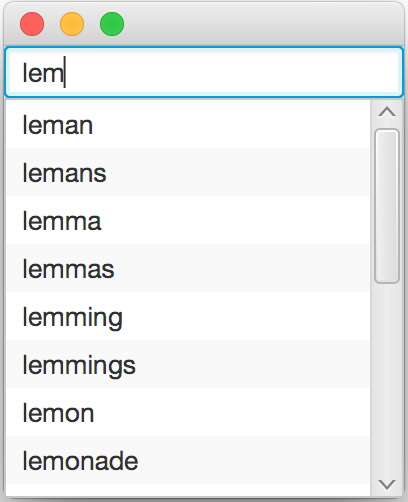Lab 12: Text Prediction
Overview
In this lab, we will implement a trie for storing strings and use it
to predict words as they are being typed.
Setup
Description
Modern smartphones include keyboard assistants that will suggest words
while you are typing. There are many data structures that can be used to
assist in this interaction, to predict the remainder of words, and
autocorrect typed words. One such data structure is a trie, which
divides the words into their component characters, and then stores the
words in such a way that words with a shared prefix share a part of the
tree.
There are two main components to the model found in the skeleton
project: a Trie to store the tree of strings, and a SortedArrayMap
to map characters to child Tries. SortedArrayMap in turn is
implemented in terms of a SortedArray class.

You will only have to write code in the Trie class, but you will need
to also look at the other classes to see what methods are available.
Methods that remain to be implemented in the Trie class have been
marked with TODO for easy identification.
Step 1: size
Implement the size method. It should essentially count how many Trie
nodes have isMember set to true. This can be done recursively:
- If
isMember is true, count 1.
- Add up the result of calling
size recursively on all children.
To iterate over all children, you can use a foreach loop, which depends
on the iterator() method from SortedArrayMap.
Step 2: find
Implement find, a helper method you may find useful later. It follows an entire String through the trie, taking one step down per character. It returns a stack of Trie nodes that trace the path that corresponds to the prefix, pushing the Tries onto the stack as it descends. If the prefix is not present, the stack will contain Tries for all of the leading characters from the prefix that are present. The stack is implemented using an object of the ArrayDeque class. It does not matter whether isMember is set or not.
You might find the method getChildWith helpful as you write this method.
Step 3: contains, add, remove
The implementations of all three of these methods will be much simpler
if find is employed as a helper method.
-
Implement contains, which tests whether a given string is
contained in the trie (note “contained” means “isMember is set”).
-
Implement add, which adds a new word to the trie.
-
Implement a simple version of remove, which simply finds the end
of the word to remove and then sets isMember to false. This will
pass all the tests but leaves lots of useless Trie nodes lying
around; you will fix this in Step 5.
Step 4: inorder, successorsTo
Implement inorder and successorsTo. See the comments in the code for
descriptions of what they should do.
The implementation of successorsTo will be much simpler
if find is employed as a helper method.
Step 5: better remove
Implement a better version of remove, which actually deletes any
unneeded Trie nodes. The stack of nodes returned by find will be
helpful in this task.
Grading
- To Partially Complete this lab, complete Steps 1, 2, and 3.
- To Complete this lab, do the above and complete Steps 4 and 5.